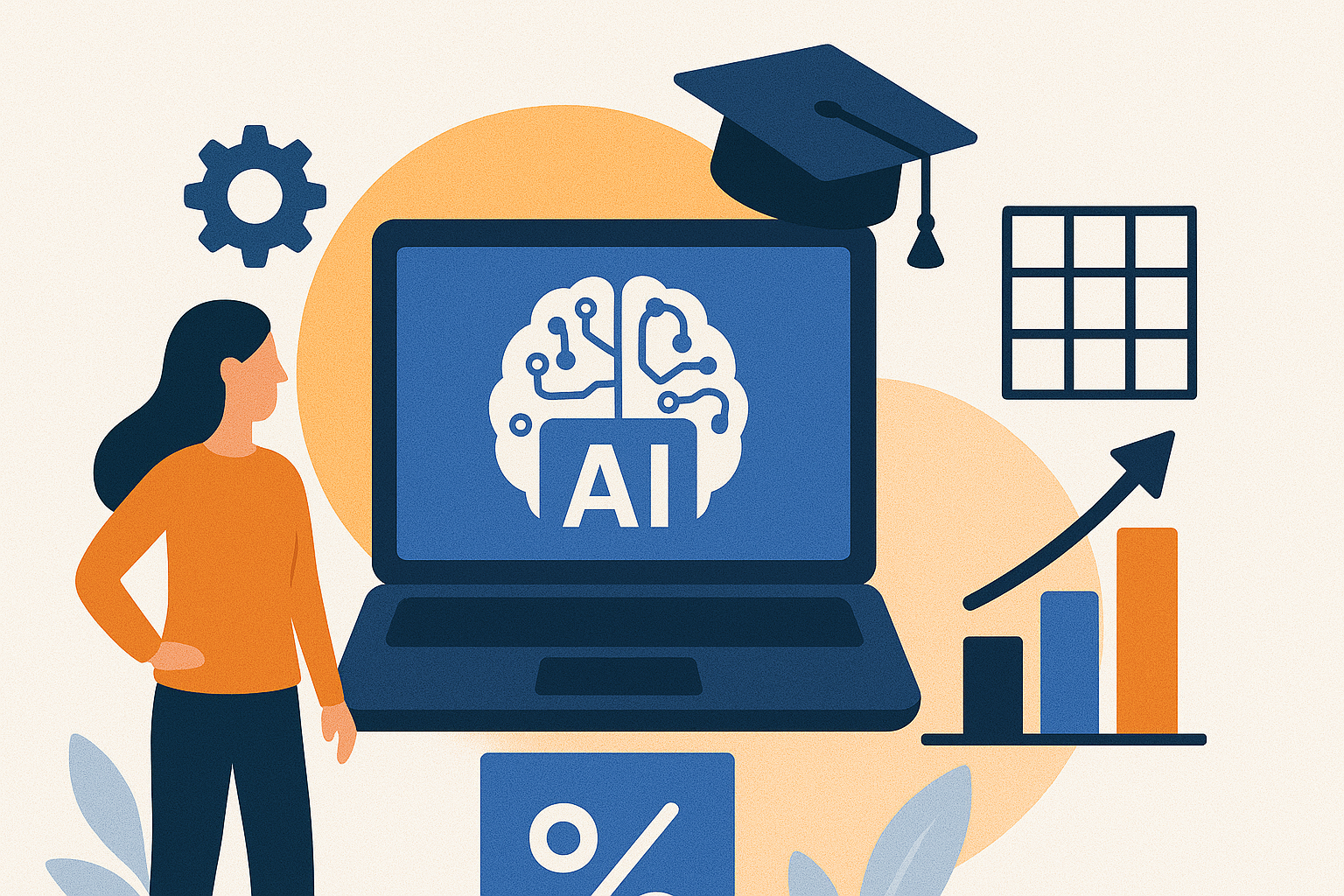About the Blog
How the University of Florida’s Warrington College of Business Tripled Leads and Cut Costs in Half with a Smarter AI Strategy
What if you could triple your leads and reduce your marketing spend by 50%?
That’s not a pipe dream—it’s the reality Jeff Holeman and his team at the University of Florida’s Warrington College of Business made happen. In this playbook, we break down how they overhauled their paid lead generation strategy, leveraged AI ad tools, and implemented a lead scoring system that empowered their admissions team to focus on the prospects most likely to convert.
Here’s your step-by-step guide to how they did it—and how you can, too.
Step 1: Audit Your Current Strategy
Why You Need to Stop Doing "Advertising for Advertising’s Sake"
When Jeff stepped into his role, he inherited a marketing machine that was active—but not strategic. Ads were running, but no one was measuring performance, ROI, or impact on enrollment.
“Everything was really very top of the funnel oriented,” Jeff explains. “And I wanted to change that.”
Start Here:
- Map out your current ad spend across platforms.
- Measure lead volume, conversion rates, and cost per lead (CPL) by channel.
- Identify where data gaps exist—especially between marketing and admissions.
Ask yourself: Are we optimizing based on outcomes or just impressions?
Step 2: Embrace AI-Powered Ad Platforms
From Lookalike to Actalike Audiences
One of the biggest shifts Jeff’s team made was moving from old-school demographic targeting (think age, location, job title) to behavior-based targeting powered by AI.
“Instead of finding someone who looks like your audience, you’re targeting people who act like your audience,” Jeff says.
By feeding first-party data (from CRMs, applications, email engagement, and more) into platforms like Google Demand Gen, Performance Max, and LinkedIn ads for higher education, they let the algorithms work smarter—not harder.
What to Do:
- Export your first-party lead and applicant data—demographics, behaviors, application status.
- Feed it into your ad platforms to train the AI on your ideal prospects.
- Focus your spend on Google Demand Gen, LinkedIn, and Meta (if applicable)—but evaluate performance platform by platform.
Pro Tip: LinkedIn proved most effective for grad programs, where career intent and professional behavior matter more than age or geography.
Step 3: Align Automation with Human Oversight
No Autopilot Allowed
Even the smartest AI needs a co-pilot. Jeff’s team balances automation with intentional human oversight through constant data monitoring and agency collaboration.
“You don’t get to just let go and say, let automation, let AI take over. There’s no autopilot marketing.”
Best Practices:
- Review campaign performance weekly (at minimum).
- Flag high-cost or underperforming campaigns early.
- Set clear expectations with any external agency partner: AI should accelerate human strategy, not replace it.
Think of it like air traffic control: You’re not flying every plane, but you’re watching every radar screen.
Step 4: Build a Lead Engagement Scoring Model
Focus Your Admissions Team on the Hottest Leads
With hundreds of new leads rolling in, Jeff knew the admissions team needed a way to prioritize outreach. Enter: lead engagement scoring.
His team built a simple three-tier model using their existing Salesforce-based marketing automation platform. Here’s a deeper dive into how to build a lead scoring model.
How It Works:
- Hot leads = Scores of 100+ based on high-intent behaviors (event registration, scheduling calls)
- Average leads = Moderate engagement (email clicks, website visits)
- Low leads = Minimal or one-time actions (form fills with no follow-up)
Implementation Tips:
- Start by auditing what activities you can track: form fills, email opens, page views, event sign-ups, etc.
- Assign point values based on importance and intent.
- Use your CRM or marketing automation tool to automate scoring if possible.
If you don’t have built-in tools:
- Create a manual scoring sheet using Excel or Google Sheets.
- Keep it simple—track just 3–5 key activities and assign values (e.g. Info session = 40 pts, Email click = 10 pts).
Step 5: Simplify Your Lead Forms
Don’t Ask for More Than You Need
If your Request for Information (RFI) forms are too long, you're losing leads before you even start.
Jeff’s winning form? “Name, email, program of interest. That’s it.”
They’re currently A/B testing whether requiring a phone number helps or hurts conversions.
Your Action Plan:
- Review your existing lead forms. What’s absolutely essential?
- Remove unnecessary fields—especially on mobile.
- Test variations (with/without phone number, interest level questions, etc.)
Step 6: Start Small. Invest Smart.
You Don’t Need a Big Budget—You Need a Smart One
Jeff’s team generated a 30% increase in applications for a niche doctorate program with just $20K over four months.
“You don’t need millions. Start small and invest smart.”
How to Do It:
- Pick one high-value program to test a new AI-driven strategy.
- Set a modest budget ($5K–$20K).
- Feed first-party data to ad platforms and monitor results weekly.
- Use performance data to make your case for expanded investment.
Final Thoughts: Where to Go From Here
If you want to scale your enrollment marketing results without scaling your costs, this playbook offers a clear roadmap:
- Ditch outdated demographic targeting.
- Feed your ad platforms rich first-party data.
- Build engagement scoring to focus your team’s efforts.
- Embrace automation—but always stay in the cockpit.
- Test, learn, and iterate.
As Jeff puts it: “Be bold and try something different. You don’t have to have millions to make it work.”
Frequently Asked Questions
Q1: What is first-party data, and how do I use it for lead generation?
A: First-party data is information you collect directly from your audience—like form submissions, website activity, email engagement, and CRM data. To use it in lead generation, feed this data into platforms like Google Demand Gen or LinkedIn Ads to train the algorithms to find people who act like your current leads.
Q2: What platforms did the University of Florida team use for their campaigns?
A: The team found the most success with:
- Google Demand Gen and Performance Max
- LinkedIn Ads for Higher Education
- Meta (Facebook/Instagram)—less effective over time for grad students
Q3: How does lead engagement scoring work, and why does it matter?
A: Lead engagement scoring assigns point values to actions leads take (like attending events or clicking emails). This helps your admissions team focus on high-intent prospects and avoid wasting time on passive leads. Learn more about lead scoring best practices.
Q4: What if I don’t have a CRM or marketing automation platform with scoring features?
A: You can still build a simple model manually using Google Sheets or Excel. Focus on 3–5 key actions that show engagement, assign point values, and create a 3-tier system to prioritize leads.
Q5: Is AI-based advertising safe without losing human oversight?
A: Yes—as long as you review campaign data regularly, collaborate with agency partners, and treat AI as a tool that enhances (not replaces) your strategic thinking.
Q6: Do I need a huge budget to get started?
A: Not at all. You can launch a pilot with $5K–$20K, monitor results closely, and build your case for more funding.
Q7: What should I include in my lead forms?
A: Keep it simple. Ask for name, email, and program of interest. Test other fields like phone number or level of interest, but prioritize minimizing friction.
Want to Learn More?
- 🔗 Listen to the full episode of The Application with Jeff Holeman
- 🔗 Explore how Element451 powers smarter enrollment marketing










